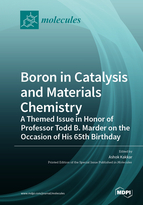Boron in Catalysis and Materials Chemistry: A Themed Issue in Honor of Professor Todd B. Marder on the Occasion of His 65th Birthday
A special issue of Molecules (ISSN 1420-3049). This special issue belongs to the section "Organometallic Chemistry".
Deadline for manuscript submissions: closed (1 June 2020) | Viewed by 32956
Special Issue Editor
Interests: nanostructures; soft nanoparticles; macromolecules; dendrimers; miktoarm polymers; telodendrimers; naked nanocarriers; metal nanoparticles; gold nanoshells; iron oxide nanoparticles; nanomedicine; drug delivery; diagnostics
Special Issues, Collections and Topics in MDPI journals
Special Issue Information
Dear Colleagues,
Dr. Todd B Marder is an eminent inorganic chemist who has made key contributions to the areas of metal-boron and organometallic chemistry. His fundamental research has led to applications in a diverse range of areas including homogeneous catalysis, nonlinear optics, crystal engineering, as well as small molecule triggers of stem cell differentiation. He has been a great promoter of collaborative academic efforts to resolve key problems in science. Dr. Todd Marder is currently a Professor and Chair of Inorganic Chemistry at the institute of inorganic chemistry, Julius-Maximilians-Universitat, Wurzburg, Germay. He received his undergraduate training in science (BSc, 1976) at the Masschusetts Institute of Technology, and his graduate studies (PhD, 1981) at the University of California under the direction of Professor Fred Hawthorne. He completed his post-doctoral studies in the laboratory of Professor FGA Stone at the University of Bristol (UK). After a short stint at DuPont in Wilmington, Delaware (USA), he began his academic career at the University of Waterloo (Canada) in 1985, and was quickly promoted to full professor in 1993. He subsequently moved to University of Durham in England in 1997 as Chair of Inorganic Chemistry, which he held until 2012. He then took up the position of Professor and Chair of Inorganic Chemistry in 2012 at the Institut für Anorganische Chemie, Universität Würzburg, Germany.
Professor Marder has received several awards including the Rutherford Memorial Medal for Chemistry (1995); the Royal Society of Chemistry Award in Main Group Element Chemistry for his contributions to the chemistry of boron and its organometallic compounds, and to their applications in the development of catalysts and chromophores (2008); JSPS Invitation Fellowship by the Japan Society for the Promotion of Science (2010); Humboldt Research Award by the Alexander von Humboldt Foundation in Germany (2010); Wolfson Research Merit Award by the Royal Society, UK (2010); and the Royal Society of Chemistry Award in Organometallic Chemistry (2015). He has held several Visiting Professorships worldwide, and has served on the editorial boards of several high impact journals. He has a high h-index and his publications are among some of the highly cited.
“Molecules” is highly pleased to host a Special Issue, and invites scientists to submit original contributions to “Boron in Catalysis and Materials Chemistry: A Themed Issue in Honor of Professor Todd B. Marder on the Occasion of His 65th Birthday.
Prof. Dr. Ashok Kakkar
Guest Editor
Manuscript Submission Information
Manuscripts should be submitted online at www.mdpi.com by registering and logging in to this website. Once you are registered, click here to go to the submission form. Manuscripts can be submitted until the deadline. All submissions that pass pre-check are peer-reviewed. Accepted papers will be published continuously in the journal (as soon as accepted) and will be listed together on the special issue website. Research articles, review articles as well as short communications are invited. For planned papers, a title and short abstract (about 100 words) can be sent to the Editorial Office for announcement on this website.
Submitted manuscripts should not have been published previously, nor be under consideration for publication elsewhere (except conference proceedings papers). All manuscripts are thoroughly refereed through a single-blind peer-review process. A guide for authors and other relevant information for submission of manuscripts is available on the Instructions for Authors page. Molecules is an international peer-reviewed open access semimonthly journal published by MDPI.
Please visit the Instructions for Authors page before submitting a manuscript. The Article Processing Charge (APC) for publication in this open access journal is 2700 CHF (Swiss Francs). Submitted papers should be well formatted and use good English. Authors may use MDPI's English editing service prior to publication or during author revisions.
Keywords
- Boron compounds
- Diboranes
- Metal-boron compounds
- B-H Activation
- Organometallic chemistry
- Homogeneous catalysis
- Boron in cross-coupling reactions
- Borylation
- Carbon-boron coupling
- Catechol-, Pinacol-, and Neopentaneglycolborane
- Fluorescence agents
- Chromophores
- Imaging
- Luminescent organometallics
- Nonlinear optics
- Crystal Engineering
- Synthetic Retinoids
- Boron in biology







